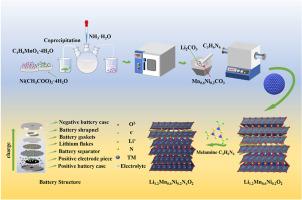N掺杂提高了无钴富锂层状正极材料的倍增能力和循环稳定性
IF 7.9
2区 工程技术
Q1 CHEMISTRY, PHYSICAL
引用次数: 0
摘要
无钴富锂层状氧化物(LLOs)因其高比容量和高电压特性成为储能科学研究的新热点。然而,诸如过渡金属的溶解和耗尽、不可逆氧释放引起的循环不稳定性以及结构转变等挑战阻碍了它们的商业应用。本研究采用碳酸盐共沉淀法和高温固相法,在衬底材料中掺杂不同量的N,合成Li1.2Mn0.6NxNi0.2O2 (x = 0,0.01, 0.02, 0.03)。掺2% N的正极材料表现出最佳的电化学性能。这种改善归因于N的引入,它占据了氧位点,扩大了晶格间距,减轻了材料中Li+/Ni2+的混合,提高了晶格氧含量。这导致更好的循环稳定性和卓越的性能,在多个循环。经过0.1C 100次循环测试后,改性样品的容量保持率提高了27.18%,循环过程中的电压衰减限制在0.342V。该研究引入了一种新的阴离子掺杂方法来开发高性能、无钴、富锂的锰基正极材料,提高了放电效率和循环稳定性。本文章由计算机程序翻译,如有差异,请以英文原文为准。

N doping promotes the multiplication capability and cycling stability of cobalt-free lithium-rich layered cathode materials
Cobalt-free lithium-rich layered oxides (LLOs) become a new hotspot in energy storage science due to their high specific capacity and high voltage. However, challenges such as the dissolution and depletion of transition metals, cycling instability due to irreversible oxygen release, and structural transformations hinder their commercial application. In this study, Li1.2Mn0.6NxNi0.2O2 (x = 0, 0.01, 0.02, 0.03) is synthesized by de-doping the substrate material with varying amounts of N using carbonate co-precipitation and high-temperature solid-phase methods. The cathode material doped with 2 % N exhibits the best electrochemical performance. This improvement is attributed to the introduction of N, which occupies oxygen sites, enlarges the lattice spacing, mitigates the mixing of Li+/Ni2+ in the material, and enhances lattice oxygen content. This leads to better cycling stability and excellent performance during multiple cycles. The modified sample shows a 27.18 % increase in capacity retention after 0.1C 100-cycle testing, and voltage decay during cycling is limited to only 0.342V. The study introduces a novel approach for anion doping to develop high-performance, cobalt-free, lithium-rich manganese-based cathode materials with enhanced discharge efficiency and cycling stability.
求助全文
通过发布文献求助,成功后即可免费获取论文全文。
去求助
来源期刊

Journal of Power Sources
工程技术-电化学
CiteScore
16.40
自引率
6.50%
发文量
1249
审稿时长
36 days
期刊介绍:
The Journal of Power Sources is a publication catering to researchers and technologists interested in various aspects of the science, technology, and applications of electrochemical power sources. It covers original research and reviews on primary and secondary batteries, fuel cells, supercapacitors, and photo-electrochemical cells.
Topics considered include the research, development and applications of nanomaterials and novel componentry for these devices. Examples of applications of these electrochemical power sources include:
• Portable electronics
• Electric and Hybrid Electric Vehicles
• Uninterruptible Power Supply (UPS) systems
• Storage of renewable energy
• Satellites and deep space probes
• Boats and ships, drones and aircrafts
• Wearable energy storage systems
 求助内容:
求助内容: 应助结果提醒方式:
应助结果提醒方式:


